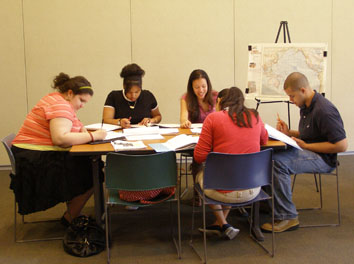 תצוגת תוכן אינטרנט
תצוגת תוכן אינטרנט
Understanding Document Based Research:
DBQs and Primary Sources
Click here to download the printable version of this page.
The study of history and social studies in schools today is based on primary source documents. This section will explain what document-based questions and primary source documents are.
What is a Primary Source?
Just what do we mean when we use the term primary source or primary source document? A primary source is generally defined as a record created by a direct participant in an event or activity in the past. Primary sources are not always documents. Many times they are, but maps, photographs, drawings, and objects are also primary sources. In document-based teaching of history, they are all considered "documents."
Primary sources differ from secondary sources in that secondary sources are interpretations of the past-usually written by historians-that are created after the fact. For example, a diary written by a Civil War solider is a primary source, because the solider is a first-hand participant in the events he is describing. A chapter in a text book and an article written about the Civil War are secondary sources.
The following are considered primary sources:
- Reports
- Maps
- Photographs
- Letters
- Journals
- Scrapbooks
- Yearbooks, Wills, Birth Records
- Military Service Records
- Tax Records
- Historic Objects
- Event Programs
- Films and Videos
- Audio Recordings
- Blueprints and Architectural Designs
- Awards, Trophies and Certificates
What is a DBQ (Document Based Question)?
When students answer document-based questions, they become detectives searching evidence for clues. A DBQ (document-based question) is designed to build students' critical thinking skills by asking them to interpret, analyze and synthesize information from primary sources.
The goal in using document-based questions is to get students to look beyond the obvious interpretation of a primary source to understand not just what the document, object, or artifact shows and says, but more importantly what it means. Students begin to realize that sometimes history is written based on interpretations of very small fragments of evidence. And so the question of who is doing the interpreting, as well as the quality and quantity of the evidence being examined, become very important considerations.
How are Primary Sources Helpful in Learning?
Using primary sources in the classroom helps students develop the critical thinking skills that make learning tangible, enjoyable and memorable. Primary sources are helpful because they allow students to learn to:
 Interpret
Interpret- Explain
- Apply
- Clarify
- Evaluate
- Form Opinions
- Compare and Contrast
- Empathize
- Describe
- Assess
- Establish Perspective
- Identify Contradictions
- Weigh Generalizations
- Analyze Raw Data
- Examine Evidence
- Draw Conclusions



